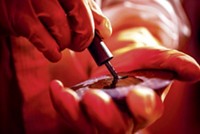Advertisement
Grab your lab coat. Let's get started
Welcome!
Welcome!
Create an account below to get 6 C&EN articles per month, receive newsletters and more - all free.
It seems this is your first time logging in online. Please enter the following information to continue.
As an ACS member you automatically get access to this site. All we need is few more details to create your reading experience.
Not you? Sign in with a different account.
Not you? Sign in with a different account.
ERROR 1
ERROR 1
ERROR 2
ERROR 2
ERROR 2
ERROR 2
ERROR 2
Password and Confirm password must match.
If you have an ACS member number, please enter it here so we can link this account to your membership. (optional)
ERROR 2
ACS values your privacy. By submitting your information, you are gaining access to C&EN and subscribing to our weekly newsletter. We use the information you provide to make your reading experience better, and we will never sell your data to third party members.
Physical Chemistry
'Dusters' Look For Interstellar Dust Tracks
by Elizabeth K. Wilson
January 22, 2007
| A version of this story appeared in
Volume 85, Issue 4

When science gets too big, it's time to either automate or call in volunteers. Sometimes, you have to do both.
Pieces of aerogel on NASA's Stardust spacecraft not only picked up samples of comet Wild 2, they also captured, separately, particles of interstellar dust on a side of the collector not exposed to the comet. The comet particles are easily detectable, but scientists estimate that the interstellar dust collector may have nabbed only a dozen or so. Finding the tracks of these micrometer-sized particles in a 1,000-cmm2 collector area is akin to finding the needle in the proverbial haystack.
"By the time you've set the microscope magnification high enough to see the particles, you have to look through millions of images," says Zack S. Gainsforth, a researcher in the space sciences laboratory at the University of California, Berkeley.
Inspired by SETI@home—the project that harnesses volunteered home computers to analyze radio signals for traces of intelligent life—just down the hall, Andrew J. Westphal, an associate director of the space lab, created a website called Stardust@home (stardustathome.ssl.berkeley.edu). He and his colleagues set up an optical microscope to log sets of images, then put out a call to volunteers—anyone with a computer—who could pore over the 1.5 million sets in hopes of spotting the elusive dust.
Stardust@home has spawned an avid online community of some 20,000 science buffs around the world who have dubbed themselves "dusters." Some are casual users and others spend hours every night perusing images. There's a carrot involved—the first people to identify particles will be listed as coauthors on a paper announcing the results. So far, Gainsforth says, they have some promising leads. At least four people scan each segment, and if it's flagged as promising, it gets more scrutiny from dusters and scientists. Would-be dusters register online at the Stardust@home site and take a short test to make sure they can correctly identify potential particles. "I think it's wonderful—the fact that we do need people," Gainsforth says. "It's exciting to deal with 10,000 active volunteers all the time."
- Comet Wild 2's Complex Chemistry
- Particles and gas harvested during Stardust Mission were Formed in a turbulent early solar system.
- Stardust@home
- 'Dusters' Look For Interstellar Dust Tracks
- Video: Spacecraft Trajectory *
- Stardust followed this orbit as it caught up with comet Wild 2, then returned a capsule filled with comet particles to Earth.
- Video: Stardust Capsule Reentry *
- This movie taken from a NASA DC-8 aircraft shows the Stardust sample return capsule entering the atmosphere in the early morning hours of Jan. 15, 2006.
- Image: Treasure Chest
- The capsule came to rest on the Utah desert floor.
* Macromedia Flash Player 8 is required to view videos.




Join the conversation
Contact the reporter
Submit a Letter to the Editor for publication
Engage with us on Twitter